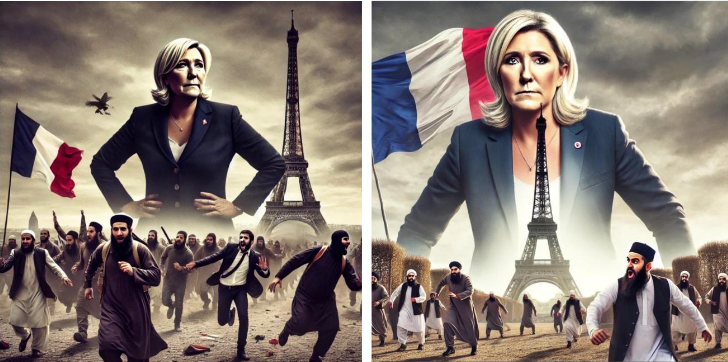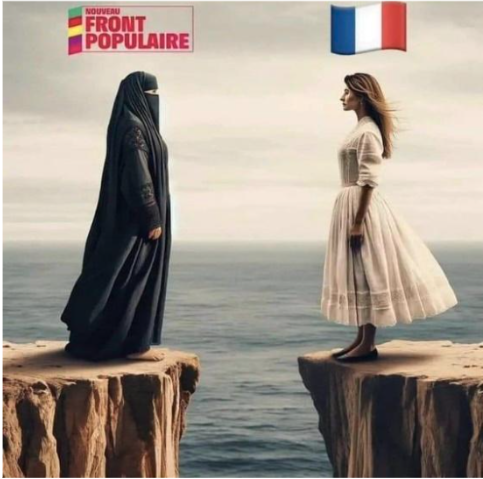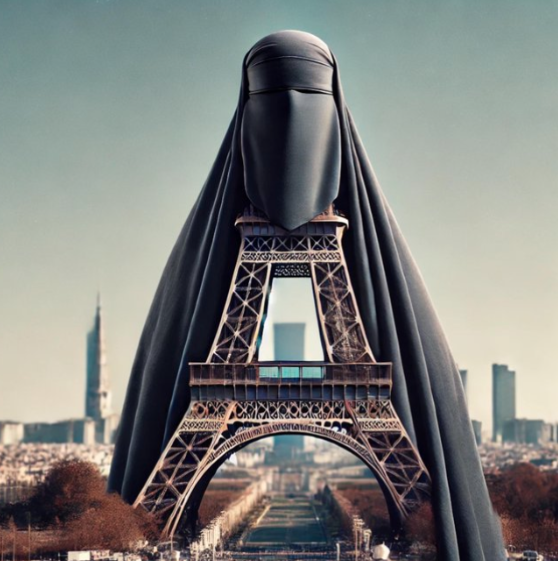Introduction
In the wake of the recent European elections, Emmanuel Macron stunned the continent following his party’s disappointing showing by calling for a snap election to the French parliament. The move backfired, with Rassemblement National winning the plurality of the votes (33.21%) in the first round of elections on the 30th of June, with the leftist New Popular Front and Macron’s Ensemble trailing behind. This result resonated well beyond France, with Anglophone reactionary accounts celebrating the victory and intensifying pro-Le Pen posting before the second round. Amidst the Rassemblement National’s prevailing optimism, the party’s underperformance in the second round sparked disbelief; triggering the manufacturing of the apocalyptic visions of France ruled by the Leftist coalition.
This Insight will map extreme-right discourse before and after the final parliamentary results. The analysis focuses on X, as it allows for tracking the mainstreaming of extremist content. Special attention will be paid to the use of AI in extremist propaganda, as it enables the mass production of text and images with little effort. Indeed, the images under consideration have been uploaded with staggering frequency, creating a multimedia repository for other accounts. This Insight aims to analyse a fluctuating reception of the results of the French elections by Anglophone extreme-right accounts, thereby opening up a broader discussion about the flooding of social media with AI-generated extremist content.
Marine Le Pen as “the Savior”
In the aftermath of the first round, extreme-right posters embraced a triumphalist tone. The French election became a global symptom of the people ‘waking up’ to the danger of ‘Islamization’ and standing up to the so-called complacent elites. In this framing, Marine Le Pen features as the sole figure that can protect France, symbolised by the imagery of the Eiffel Tower, from the ‘Muslim invasion’. Figure 1 captures the potential of AI to endlessly reimagine the same set of symbols as images convey consistent messaging amidst the aesthetic changes. Notably, the creator juxtaposes Le Pen against all other politicians who willfully pursue the agenda of multiculturalism to the detriment of the French people. In invoking the frame of the French culture subjugating Islam with the help of liberal elites, extreme-right accounts refer to the Great Replacement conspiracy theory. This framing will become even more salient for visualising the purported consequences of the ultimately lost elections.

Figure 1: Marine Le Pen pictured as the defender of France stoking fear amongst Muslim men.
The ‘Clash of Civilizations’
Alongside the premature celebrations of the ‘rebirth’ of France, extremist accounts have actively partaken in campaigning on behalf of the Rassemblement National. The formation of the broad leftist coalition made negative campaigning easier by clearly delineating the group purportedly responsible for the French decline. Figure 2 depicts New Popular Front as a woman in a niqab, juxtaposed against a woman in a white dress that symbolises France. In doing so, the image constructs a figure of an anti-French block of leftists and Muslims, implicitly equating the Rassemblement National with essentialised Frenchness.
The framing of the election as the conflict between French patriots and Muslims supported by the Left relies on the repertoire of the clash of civilizations theory. According to this logic, inter-cultural differences constitute a primary source of conflict between Western and Islamic civilizations pitted against each other. The rift in Figure 2 constitutes a suggestive visualization of irresolvable cultural differences. The composition of the image, as well as the contrasting use of colour, strengthen the sense of imminent conflict over the future of France.

Figure 2: the woman in a niqab and the woman in a white dress illustrate the purported alternative the voters face.
‘Islamic Republic of France’
Contrary to the expectations of the network of extreme right actors on X, the French electorate did not vote for their preferred outcome. Rassemblement National secured 24.6% of the seats, trailing behind the New Popular Front (32.6%) and the government party, Ensemble (27.9%)
Unsurprisingly, the triumphant mood quickly shifted into despair with the election result portrayed as the ‘fall of France’ (Figure 3). With Marine Le Pen no longer able to protect the French nation (Figure 1), the symbol of French culture- the Eiffel Tower- falls prey to the ‘Islamic’ culture. Notably, although a different user produced this imagery, one can easily track the continuity in terms of imagery and aesthetics.
Beyond the consistent use of the Eiffel Tower, one can also see a consistent use of the traditional Muslim headwear to symbolise the enslavement by the Islamic culture. Figure 3 uses this imagery to signal the subjugation of the French Republic to Islamic customs following the electoral victory of the Left. This narrative employs femonationalist rhetoric that selectively weaponises the language of emancipation of women to demonise minority groups. The depiction of Islam as the enslaving force looming over the lives of emancipated women is commonplace in French culture. Be it in true sex crime novels or the banning of abayas in schools, the language of gender equality offers far-right tools to criticise the presence of Islam in public life in an acceptable way.

Figure 3: renderings of the fall of France symbolized by the altered Eiffel Tower.
Similarly, the racialised and gendered notion of replacing the ‘native’ with an incoming population reoccurs in this imagery. Figure 4 depicts the typical depiction of the post-election ‘replacement’ that took over X in various alterations. Besides the perennial Eiffel Tower background, imagery features a white, blonde woman crying over the fate of France, with a crowd of men of colour celebrating in the background. The figure of a young woman plays a dual role by instilling the fear of gendered-based violence coming from hyper-sexualised Muslim men and symbolising the country itself – mournful and helpless in the face of the incoming threat.
The spread of images packed with ‘Great Replacement’ symbolism proves the recent scholarly effort to grasp the visual encoding and compression of conspiracist tropes worthwhile. Indeed, while communicating conspiratorial material via text faces a trade-off of depth and digestibility, a single image enables one to communicate complex messages in an appealing format. In line with the understanding of population replacement discourse as a palimpsest of constantly over-written ideas, slight changes in AI prompt allow for infinite repacking of the same idea. Figure 4 illustrates this malleability of visual-based conspiracism, with one image linking the ‘replacement’ with pro-Palestine protests (left) and another ridiculing the notion of a prayer mat by showing it covered with trash, including the desecrated French flag (right).

Figure 4: a white woman lamenting after the electoral results in the second round.
The Implications of AI Propaganda Farms
As detailed in this Insight, the French election caused a flurry of activity from extreme-right Anglophone actors on X. AI imagery has proven instrumental in expressing hope of the imminent victory and the disappointment and anger sparked by the electoral defeat. The low bar of accessing and using this technology allows extremist actors to flood social media platforms with reactionary imagery with little effort. The remarkably consistent use of themes throughout different iterations allows these actors to produce ideologically consistent visual content on a mass scale. Instead of curating perfectly calibrated social media content, a steady stream of consistent messaging can achieve the same goal.
Given the ease of mass-producing AI-generated imagery, one should assume that this type of content will remain an integral part of our feeds for time to come. Although the cost and accessibility of this technology might make it less appealing in the distant future, legislators should take this development seriously and develop tools and regulate it effectively, without infringing on freedom of speech or expression. Meta and TikTok announced they will tackle the problem by flagging AI-generated content, albeit doing so very differently, with Meta relying on a team of fact-checkers and TikTok developing an AI-detection algorithm. While laudable in acknowledging the problem, companies should not be left to regulate themselves, with legislators pushing for transparency and efficacy. This holds especially true for social media companies unwilling to cooperate, with X constituting a prime example.
Simultaneously, scholars and journalists should monitor the actions of all regulatory actors and continue asking pressing questions about the impact of technology on democratic life. The inquiry should not be limited to systemic challenges but also provide insights for citizens navigating their feeds flooded by AI imagery. The dire situation on Facebook prompted a conversation about the ‘Zombie Internet’ in which users interact primarily with bots and hijacked accounts of deceased people. While less mediatised, the situation on X is not better, with researchers continuously identifying clusters of AI-automated disinformation accounts. To be relevant, scholars and journalists should address this lived reality by linking abstract legislation with the shape of social media feeds that people are exposed to daily. Discussing what appears on our feeds and why is no silver bullet for disinformation, yet it may constitute the first step in making social media a genuinely social space.
Piotr Marczynski is a PhD candidate at Université Libre de Bruxelles. His thesis project concerns the use of conspiracy discourse by far-right political actors online. Interested in the imaginaries of population replacement across Europe, with a special focus on Central Eastern Europe. Mapping how niche content producers and elite accounts interact.
